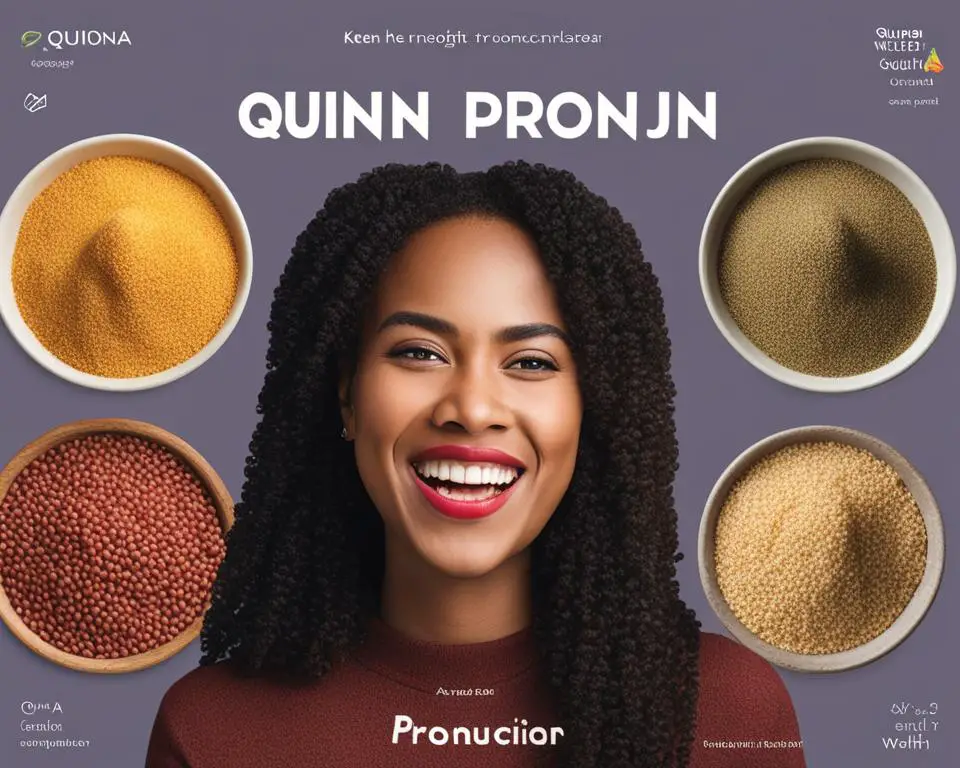If you’re new to quinoa, you may wonder how to pronounce it correctly. Our quinoa pronunciation guide is here to help you confidently say this popular grain. In this section, you will learn how to pronounce quinoa correctly, with easy-to-follow tips and techniques to guide you. Whether you’re a foodie or simply want to expand your vocabulary, this guide is for you!
First off, let’s start with the basics. Many people mispronounce quinoa as “kin-o-ah” or “kwi-no-ah,” but the correct pronunciation is “KEEN-wah.” Say it with us – “KEEN-wah.”
Next, we’ll dive deeper into different techniques and rules to help you master pronouncing quinoa accurately. By the end of this quinoa pronunciation guide, you’ll be well-equipped to confidently say quinoa correctly in any situation.
Learn the Correct Pronunciation of Quinoa
Are you struggling with the correct pronunciation of quinoa? You’re not alone. Many people find it challenging to say quinoa accurately. But don’t worry; we’re here to help you! Follow these simple quinoa pronunciation tips and rules:
Break it Down
Quinoa pronunciation can be tricky, but breaking it down into syllables can make it easier. Start with “keen” and then add “wah” and “nuh.”
Pay Attention to Vowels
When pronouncing quinoa, pay close attention to the vowels. The “i” and “o” sounds are the same as in the word “see” and “no,” respectively.
Practice Makes Perfect
Practice saying “quinoa” slowly and then gradually increase your speed. Repeat it until it feels natural and effortless.
By following these quinoa pronunciation rules and techniques, you’ll be able to say quinoa accurately without hesitation. Impress your family and friends with your new-found pronunciation skills!
Mastering the Pronunciation of Quinoa
Are you ready to take your quinoa pronunciation to the next level? In this section, we will provide you with advanced techniques to help you master the nuances of pronouncing quinoa correctly. These techniques will enable you to pronounce quinoa accurately in various situations, whether you’re ordering it at a restaurant or discussing quinoa recipes with friends.
If you want to say quinoa correctly, it’s essential to understand the correct stress placement. The stress should be on the second syllable, “KEEN-wah”. Remember to elongate the “EE” sound and enunciate the “WAH” sound.
Another useful technique to improve your quinoa pronunciation is to focus on the vowel sounds. The first syllable, “KEEN”, contains a long “E” sound, and the second syllable, “WAH”, contains a soft “A” sound. Ensure you enunciate the vowel sounds, and you’ll soon be pronouncing quinoa accurately.
Finally, practice makes perfect. You can use a range of resources to practice the correct pronunciation of quinoa, from language learning apps to YouTube videos. Practice saying “KEEN-wah” aloud and slowly until you’re comfortable with the correct pronunciation.
With these advanced techniques, you will soon master the pronunciation of quinoa. By the end of this section, you will feel confident and knowledgeable when pronouncing quinoa accurately in any setting. Practice regularly to achieve quinoa pronunciation mastery!
Conclusion
In conclusion, properly pronouncing quinoa is an essential skill for any food lover. With the help of our comprehensive quinoa pronunciation guide, you are now equipped with the knowledge and techniques to master the pronunciation of this versatile grain. Remember to focus on the unique sounds of the word and use the correct stress, and you’ll be pronouncing quinoa accurately in no time!
Practice these techniques and enjoy incorporating quinoa into your daily meals with confidence. Whether you’re preparing quinoa salads or making quinoa burgers, your accurate pronunciation will impress others and enhance your culinary vocabulary.
Thank you for reading our quinoa pronunciation guide, and we hope it has been helpful to you!
FAQ
How do you pronounce quinoa correctly?
The correct pronunciation of quinoa is “keen-wah.” The first syllable, “keen,” rhymes with “bean,” and the second syllable, “wah,” rhymes with “blah.” Remember to emphasize the “keen” part and not the “qua” part.
What are some tips for pronouncing quinoa accurately?
To pronounce quinoa accurately, start by emphasizing the “keen” part of the word. Instead of saying “kwi-noah” or “kee-no,” make sure you say “keen-wah.” Additionally, practice saying the word slowly and pay attention to the syllables. Break it down into “keen” and “wah” to help with proper pronunciation.
Are there any specific rules for pronouncing quinoa?
Yes, there are a few rules to keep in mind when pronouncing quinoa. First, remember to stress the “keen” syllable and make it more prominent than the “wah” syllable. Second, the letter “q” in quinoa is pronounced as a “k” sound rather than a “kw” sound. Lastly, the final “a” in quinoa should sound like the “ah” in “car” or “spa.”
How can I master the pronunciation of quinoa?
To master the pronunciation of quinoa, practice saying the word out loud consistently. Break it down into syllables and emphasize the “keen” part while maintaining a steady flow into the “wah” part. Listen to native speakers pronounce quinoa and imitate their pronunciation. With regular practice, you will become fluent in saying quinoa correctly.
What techniques can help me pronounce quinoa accurately?
One technique to pronounce quinoa accurately is to repeat the word multiple times, focusing on the correct stress and syllable emphasis. Another technique is to watch pronunciation videos or listen to audio samples that specifically demonstrate the correct pronunciation of quinoa. Lastly, try incorporating quinoa into various sentences or conversations to reinforce proper pronunciation.
Is it important to pronounce quinoa correctly?
While mispronouncing quinoa may not have any serious consequences, it is always beneficial to pronounce words correctly, especially when discussing food or engaging in conversations about culture and cuisine. Pronouncing quinoa accurately shows your respect for the word’s origin and demonstrates your knowledge and appreciation for diverse ingredients.

